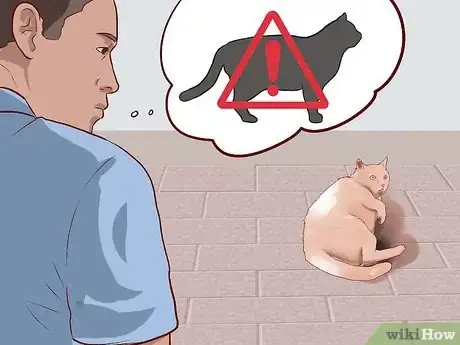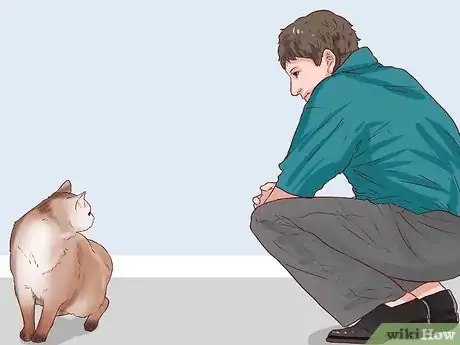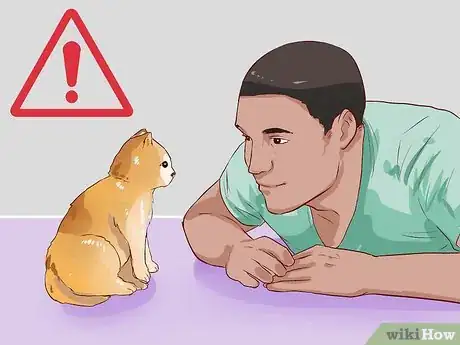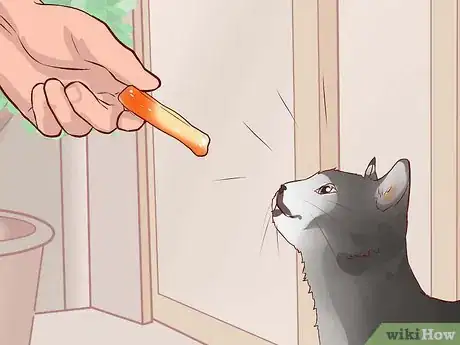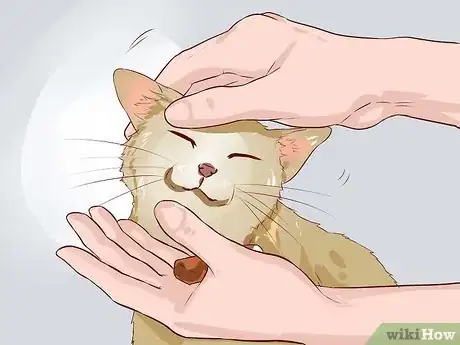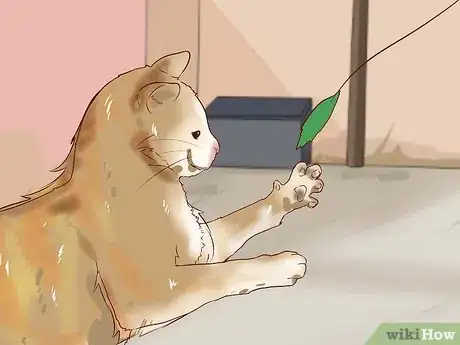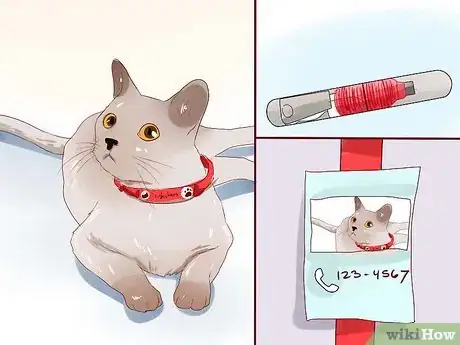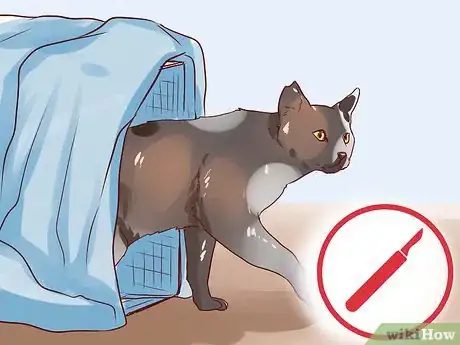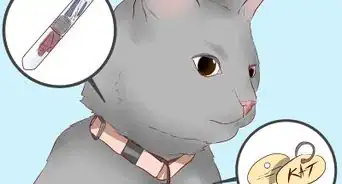This article was co-authored by Molly DeVoss. Molly DeVoss is a Certified Feline Training and Behavior Specialist (CFTBS), a Certified Cat Behavior Consultant (CCBC), a Fear Free Certified Trainer (FFCT), and the Founder of Cat Behavior Solutions. Molly specializes in using positive reinforcement to modify and prevent unwanted behaviors in cats and reduce cat shelter surrender. Molly has sat on the Dallas Animal Advisory committee since 2013 and was voted one of the Top 12 Extraordinary Cat Behaviorists of 2020 by Catpetclub.com. She is certified by both the Animal Behavior Institute and the International Association of Animal Behavior Consultants. She is also the host of the weekly podcast Cat Talk Radio.
wikiHow marks an article as reader-approved once it receives enough positive feedback. In this case, 100% of readers who voted found the article helpful, earning it our reader-approved status.
This article has been viewed 77,151 times.
Stray cats are used to fending for themselves without human care or attention. However, that doesn’t mean you can’t befriend one. With patience, you can encourage a stray to trust you. Start by offering food and letting the cat get used to your presence, and you just might gain a new feline companion.
Steps
Getting Acquainted
-
1Know what kind of cat you are dealing with. Before you begin to try making friends with a stray cat, make sure you can identify what kind of cat it is.[1]
- A free-roaming cat has an owner that takes care of it, but allows it to wander around on its own. You should probably not try and befriend a free-roaming cat; if you begin to feed it or let it in your home, it might abandon its owner.
- Other cats are strays. A stray cat is one that formerly had an owner, but the owner no longer takes care of it, or abandoned the cat. Stray cats may roam widely, taking food and shelter where it can find it. Some stray cats may be willing to make friends with you, or let you pick them up and take them to an animal shelter.
- Some cats are feral, meaning that they have spent all or nearly all of their lives outdoors and without any human care. Many feral cats were born and raised this way, returning to a nearly-wild state, preferring to stay away from people. Some feral cats are willing to make friends with you, but generally it is difficult to domesticate them.
-
2Try to note the cat's condition. Because it has spent time outdoors and without regular care, your stray cat might be hungry, sick, scared, or injured. Some stray cats may be friendly, walk right up to you, and allow you to pick them up and inspect them. If the cat runs away or acts scared, however, you will have to entice it to stay around.Advertisement
-
3Offer food. Letting a stray cat know that food is available is one of the most effective ways to start making friends with it. Pay attention to where you’ve seen the stray cat, and leave some food in the area.[2]
- Strong-smelling foods like tuna or canned cat food make good choices.
- Leave food in the same spot everyday; this will make the cat come back and expect to treat.
- Observe when the cat comes and eats the food you have left outside for it. After a few days, wait near the food, and see if the cat will come and eat while you are within sight.
- Don’t try to pet or pick up the cat at first.
-
4Approach the cat. Try waiting near the cat as it eats over the course of a few days. Once it seems very familiar with your presence, you can try to approach it. Move slowly, and sit on the ground. This will make you look less intimidating. Try this again and again for several days, moving a little closer to the food each time.
- You could also let the cat approach you on its own timeframe and comfort level.[3]
Making Contact
-
1Avoid confrontational behavior.[4] Avoid staring the cat in the eye or trying to reach for it when you first see it. These gestures can be perceived as threatening, especially for cats that are not used to being around people. Act calmly and quietly, and focus on getting the cat to trust you.
-
2Play hard to get.[5] If your stray cat is comfortable enough to let you be near it, pretend like you are ignoring it. Let it see you engaged in a non-threatening activity, such as reading or gardening. If you are lucky, the stray cat will observe you and learn that you are also not threatening.
-
3
-
4Entice the cat to eat from your hand.[8] If the cat comes near you, try holding a treat in your hand. The stray may feel comfortable to eat out of your hand, or it may not. In either case, do not attempt to pet or pick up the cat at first. Be patient; it takes time, sometimes weeks or more, for a stray or feral cat to begin to trust you.
- You can also try letting the cat lick a small amount of soft or wet food from your finger.
-
5Try to pet the cat.[9] Once the stray cat becomes used to eating out of your hand, you can begin to try touching it. While feeding it a treat with one hand, calmly try to gently touch the cat with your other hand. If the cat acts startled and moves away, do not try to grab it. Wait a little while and try and try again.
- If the cat will not let you touch it at first, just try to bring your hand close to it. Repeat this technique over and over again, bringing your hand a little closer to the cat each time, until it lets you touch it.
-
6Offer the cat toys if it will not let you touch it.[10] Some stray cats will respond more quickly to play that to being touched or held. If your stray cat does not seem to want to be touched, try playing with it using toy such as a laser pointer, wind-up mouse, or wand toy with feathers, ribbons, or other objects attached to it. If your cat plays with the toy, even if it won’t let you touch it or pick it up, it is a sign that it is growing accustomed to you.
-
7Don’t touch an animal that seems fearful or upset.[11] Stray and feral cats might be very conditioned to defend themselves. If yours reacts negatively when you try to touch or approach it, leave it alone and try later. A scared cat can become violent, and trying to handle it will only make it distrust you. Signs that a cat is scared or upset include:
- Tail held straight up and stiff
- Ears folded back
- Paw raised, with or without exposed claws
- ”Striking” with its paw
- Low meowing or growling
- Hissing or spitting
- Hair raised on end
- Arched back
Helping the Cat
-
1Determine if the cat has an owner.[12] If you think that the cat is a stray, you might try to reconnect it with its owner.
- If the cat has a collar or tag, check and see if it has a name, address, or phone number on it.
- A vet can check to see if there is a microchip implanted in the cat that stores information about the owner.
- If you can’t find any information about the owner, you can also try posting an advertisement with the cat’s picture at various places in your neighborhood, local animal shelters, online classifieds, etc. in hopes that the owner will track down the cat.
-
2Take the cat with you. If you are trying to take the cat home with you, to a vet, or to an animal shelter, you will need to entice it into a cat carrier. After the cat has become used to you leaving food out for it, try the following technique:
- Set the carrier near the food with the door open.
- Place food near the carrier to draw the cat near it.
- Place food nearer and nearer the carrier, if the cat will move closer to it.
- Place food inside the carrier and wait for the cat to step in and begin eating it.
- Once the cat is fully inside, close the door quickly but gently.
- Carefully carry the cat to its destination.
-
3
-
4Consider practicing trap and release. Most animal advocacy groups recommend the policy of TNR (trap, neuter, and release) for feral and stray cats.[15] This is considered a humane way of controlling stray cat populations. You can ask your vet or an animal shelter to spay or neuter your cat, and then release it back outdoors once it has recovered. You can even continue to feed the stray.
-
5Help your cat adjust to life in a new home. If you decide to permanently adopt the stray and invite it into you home, you will need to be patient and understanding; returning to indoor life can be difficult for many former strays.[16]
- Keep the cat in a quiet room at first, where it won't be disturbed.
- Make sure that the cat has food, water, a place to bed, and a litter box.
- You might need to use garden soil in the litter box at first, then a mix of soil and litter, before using just litter. This will help the stray adjust to the texture.
- Visit the cat regularly. Offer it treats, talk to it soothingly, and try playing with some toys. Pet the cat if it will let you, but leave it alone and come back later if it acts scared or aloof.
- There is a good chance that the cat will feel comfortable soon, and be ready to leave its room and explore your home. Be patient, however, as the cat might get startled and hide in various places, scratch furniture, or knock things over as it gets used to its new surroundings.
Expert Q&A
-
QuestionHow do you get a stray cat to approach you?
 Molly DeVossMolly DeVoss is a Certified Feline Training and Behavior Specialist (CFTBS), a Certified Cat Behavior Consultant (CCBC), a Fear Free Certified Trainer (FFCT), and the Founder of Cat Behavior Solutions. Molly specializes in using positive reinforcement to modify and prevent unwanted behaviors in cats and reduce cat shelter surrender. Molly has sat on the Dallas Animal Advisory committee since 2013 and was voted one of the Top 12 Extraordinary Cat Behaviorists of 2020 by Catpetclub.com. She is certified by both the Animal Behavior Institute and the International Association of Animal Behavior Consultants. She is also the host of the weekly podcast Cat Talk Radio.
Molly DeVossMolly DeVoss is a Certified Feline Training and Behavior Specialist (CFTBS), a Certified Cat Behavior Consultant (CCBC), a Fear Free Certified Trainer (FFCT), and the Founder of Cat Behavior Solutions. Molly specializes in using positive reinforcement to modify and prevent unwanted behaviors in cats and reduce cat shelter surrender. Molly has sat on the Dallas Animal Advisory committee since 2013 and was voted one of the Top 12 Extraordinary Cat Behaviorists of 2020 by Catpetclub.com. She is certified by both the Animal Behavior Institute and the International Association of Animal Behavior Consultants. She is also the host of the weekly podcast Cat Talk Radio.
Certified Feline Training and Behavior Specialist & Certified Cat Behavior Consultant Certified Feline Training and Behavior Specialist & Certified Cat Behavior ConsultantExpert AnswerGive the cat regular meals and let them approach you on their own timeframe and comfort level.
Certified Feline Training and Behavior Specialist & Certified Cat Behavior ConsultantExpert AnswerGive the cat regular meals and let them approach you on their own timeframe and comfort level. -
QuestionHow do you get a stray cat to trust you?
 Molly DeVossMolly DeVoss is a Certified Feline Training and Behavior Specialist (CFTBS), a Certified Cat Behavior Consultant (CCBC), a Fear Free Certified Trainer (FFCT), and the Founder of Cat Behavior Solutions. Molly specializes in using positive reinforcement to modify and prevent unwanted behaviors in cats and reduce cat shelter surrender. Molly has sat on the Dallas Animal Advisory committee since 2013 and was voted one of the Top 12 Extraordinary Cat Behaviorists of 2020 by Catpetclub.com. She is certified by both the Animal Behavior Institute and the International Association of Animal Behavior Consultants. She is also the host of the weekly podcast Cat Talk Radio.
Molly DeVossMolly DeVoss is a Certified Feline Training and Behavior Specialist (CFTBS), a Certified Cat Behavior Consultant (CCBC), a Fear Free Certified Trainer (FFCT), and the Founder of Cat Behavior Solutions. Molly specializes in using positive reinforcement to modify and prevent unwanted behaviors in cats and reduce cat shelter surrender. Molly has sat on the Dallas Animal Advisory committee since 2013 and was voted one of the Top 12 Extraordinary Cat Behaviorists of 2020 by Catpetclub.com. She is certified by both the Animal Behavior Institute and the International Association of Animal Behavior Consultants. She is also the host of the weekly podcast Cat Talk Radio.
Certified Feline Training and Behavior Specialist & Certified Cat Behavior Consultant Certified Feline Training and Behavior Specialist & Certified Cat Behavior ConsultantExpert AnswerFeed the kitty regularly and plant catnip in your hangout spot. When the weather gets cold, provide a heated cat den for them.
Certified Feline Training and Behavior Specialist & Certified Cat Behavior ConsultantExpert AnswerFeed the kitty regularly and plant catnip in your hangout spot. When the weather gets cold, provide a heated cat den for them. -
QuestionCan you tame a stray cat?
 Melissa Nelson, DVM, PhDDr. Nelson is a Veterinarian who specializes in Companion and Large Animal Medicine in Minnesota, where she has over 18 years of experience as a veterinarian in a rural clinic. She received her Doctor of Veterinary Medicine from the University of Minnesota in 1998.
Melissa Nelson, DVM, PhDDr. Nelson is a Veterinarian who specializes in Companion and Large Animal Medicine in Minnesota, where she has over 18 years of experience as a veterinarian in a rural clinic. She received her Doctor of Veterinary Medicine from the University of Minnesota in 1998.
Veterinarian It can be done especially if the stray was already a pet and used to people. If not (a true feral cat) it really depends on the cat's temperament.
It can be done especially if the stray was already a pet and used to people. If not (a true feral cat) it really depends on the cat's temperament.
References
- ↑ http://www.alleycat.org/StrayorFeral
- ↑ Molly DeVoss. Certified Feline Training and Behavior Specialist & Certified Cat Behavior Consultant. Expert Interview. 15 July 2021.
- ↑ Molly DeVoss. Certified Feline Training and Behavior Specialist & Certified Cat Behavior Consultant. Expert Interview. 15 July 2021.
- ↑ https://www.aspca.org/pet-care/virtual-pet-behaviorist/cat-behavior/stray-and-feral-cats
- ↑ https://www.aspca.org/pet-care/virtual-pet-behaviorist/cat-behavior/stray-and-feral-cats
- ↑ https://www.aspca.org/pet-care/virtual-pet-behaviorist/cat-behavior/stray-and-feral-cats
- ↑ Molly DeVoss. Certified Feline Training and Behavior Specialist & Certified Cat Behavior Consultant. Expert Interview. 15 July 2021.
- ↑ https://www.aspca.org/pet-care/virtual-pet-behaviorist/cat-behavior/stray-and-feral-cats
- ↑ https://www.aspca.org/pet-care/virtual-pet-behaviorist/cat-behavior/stray-and-feral-cats
- ↑ https://www.aspca.org/pet-care/virtual-pet-behaviorist/cat-behavior/stray-and-feral-cats
- ↑ https://www.aspca.org/pet-care/virtual-pet-behaviorist/cat-behavior/stray-and-feral-cats
- ↑ http://bestfriends.org/resources/what-do-when-you-find-stray
- ↑ https://www.aspca.org/pet-care/virtual-pet-behaviorist/cat-behavior/stray-and-feral-cats
- ↑ http://www.straypetadvocacy.org/socializing_a_feral_cat.html
- ↑ https://www.aspca.org/pet-care/virtual-pet-behaviorist/cat-behavior/stray-and-feral-cats
- ↑ https://www.aspca.org/pet-care/virtual-pet-behaviorist/cat-behavior/stray-and-feral-cats
About This Article
To make friends with a stray cat, leave strong smelling food, like tuna or canned cat food, in the area where you’ve seen the cat to encourage it to return. After you've done this for a few days, wait beside the food and see if the cat still comes to eat it. If it does, try sitting down on the ground and moving slightly closer to the food each day so the cat gets accustomed to your presence. Additionally, try engaging in a non-threatening activity, like reading or gardening. Once the cat appears comfortable being near you, hold a treat, like a cube of chicken, in your hand to see if it will eat it. When the cat eats from your hand, try reaching out with the other hand and petting it. For tips from our Veterinary co-author, including how to determine if the cat has an owner, read on!

